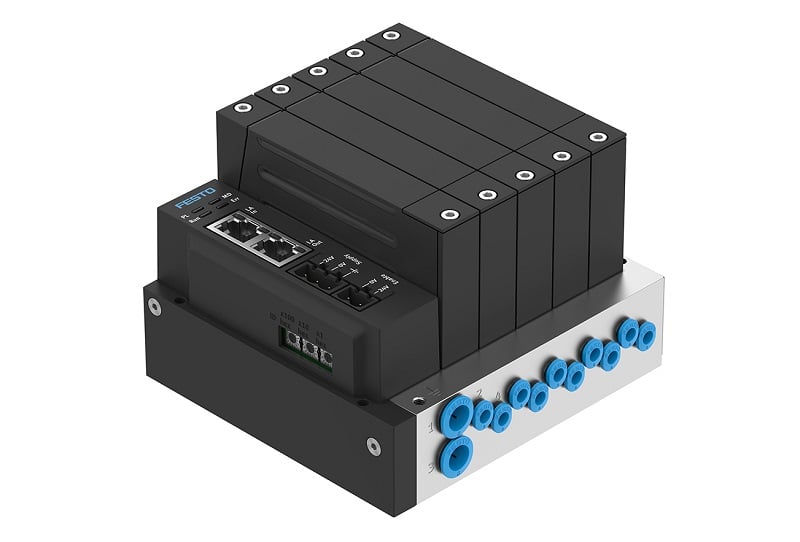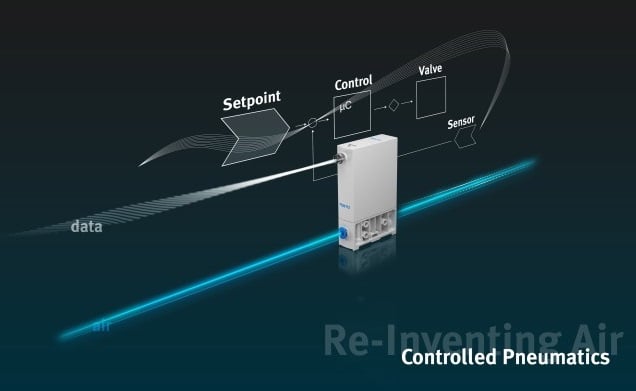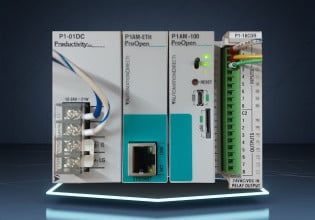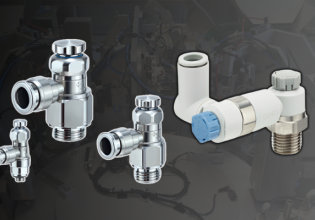Festo Makes Tech Jump With VTEP High-Precision Proportional Valve
Festo's controlled pneumatics technology is expanding possibilities for using pneumatics in automated applications. The innovative functions offered by VTEP play a role in creating these opportunities.
Airflow is one of the simplest forms of energy transfer, but it’s also one of the most difficult to control due to variations in flow rate, pressure, and fluid properties resulting from system and environmental changes.
The once-complex control device setup and intricate programming are now remarkably straightforward. Festo's closed-loop controller, featuring advanced algorithms, demands just a few input parameters. This simplified approach delivers outstanding control accuracy, with a characteristic curve closely matching the setpoint value, achieved swiftly and efficiently. At the same time, the algorithm ensures it handles unwanted vibrations and disturbances effectively, addressing them in real-time. Additionally, the VTEP utilizes the latest communication technology within a modern, real-time infrastructure.
VTEP Pressure Control
The VTEP proportional valve terminal offers three configurations: 2, 3, or 5-way styles, and can be outfitted with up to 10 working channels per terminal. With pressure ranges from 0 to 6 bar and -1 to +1 bar, it delivers strong performance in high-pressure applications and precise control in low-pressure tasks. Activating parallel working channels allows flow rate multiplication through software adjustments while maintaining pressure control using high-speed EtherCAT communication channels.

New VTEP proportional valve terminal. Image used courtesy of Festo
Digitalization of Pneumatics
With the digitalization of pneumatics, new functionalities become available. For instance, the motion complete feature from electric drives is now present in pneumatic pressure control as target reached. This feature indicates whether the setpoint has been reached or maintained, and can trigger the next process step. Additionally, the VTEP enables users to switch between various customer-specific parameters or presets during operation, allowing for the creation of different functionalities using the same valve in real-time.
Enhanced Pneumatic Control with Piezo Valve Technology
Piezo technology signifies a leap forward in controlled pneumatics, enabling precise control over pressure and flow rate. This innovation results in compact, energy-efficient valves that operate quickly with accuracy. Users can rely on programs to accurately reach specified pressure and vacuum setpoints quickly.
The proportional valve terminal VTEP features a creative bridge circuit within the valves. When piezo valves are in a unique valve bridge arrangement, it allows for controlling two separate channels simultaneously within one valve unit, as demonstrated in products such as the VTEP and Motion Terminal VTEM. These advancements reflect a commitment to furthering pneumatic technology.
Expanding Automation Possibilities with VTEP
Controlled pneumatics opens up a wide range of uses in pressure and flow control, where standard pneumatics and electric automation aren't enough.

A representation of how controlled pneumatic devices transfer data. Image used courtesy of Festo
Pressure or Vacuum Dispensing or Dosing
With the VTEP, implementing applications like patch clamping human cells using pressure and vacuum becomes feasible. Additionally, controlled pneumatics enable precise dispensing of paint, adhesives, or testing liquids according to specific recipes.
Dancer Rollers
Optimal timing enhances reliability in small and large web control processes, ensuring smooth operation. The VTEP is efficient for web control tasks like battery foil handling.
Precision Polishing with Force Control
The polisher regulates the variable contact pressure of each polishing chamber precisely using controlled pneumatics, ensuring superior polishing outcomes, especially for wafer polishing.
Process Automation Pilot Valves
Valves like the VTEP serve as pilot valves for media valves. In processes such as photolithography, precision sealing of wafers with a light-resistant coating is essential. A suck-back function prevents any excess paint from escaping.






